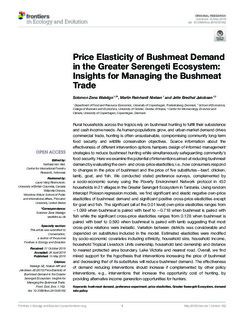| dc.contributor.author | Walelign, Solomon Zena | |
| dc.contributor.author | Nielsen, Martin Reinhardt | |
| dc.contributor.author | Jacobsen, Jette Bredhal | |
| dc.date.accessioned | 2019-10-03T08:57:35Z | |
| dc.date.available | 2019-10-03T08:57:35Z | |
| dc.date.created | 2019-05-15T16:48:28Z | |
| dc.date.issued | 2019 | |
| dc.identifier.issn | 2296-701X | |
| dc.identifier.uri | http://hdl.handle.net/11250/2619998 | |
| dc.description.abstract | Rural households across the tropics rely on bushmeat hunting to fulfill their subsistence and cash income needs. As human populations grow, and urban market demand drives commercial trade, hunting is often unsustainable, compromising community long-term food security and wildlife conservation objectives. Scarce information about the effectiveness of different intervention options hampers design of informed management strategies to reduce bushmeat hunting while simultaneously safeguarding community's food security. Here we examine the potential of interventions aimed at reducing bushmeat demand by evaluating the own- and cross-price elasticities, i.e., how consumers respond to changes in the price of bushmeat and the price of five substitutes—beef, chicken, lamb, goat, and fish. We conducted stated preference surveys, complemented by a socio-economic survey using the Poverty Environment Network protocol in 452 households in 21 villages in the Greater Serengeti Ecosystem in Tanzania. Using random intercept Poisson regression models, we find significant and elastic negative own-price elasticities of bushmeat demand and significant positive cross-price elasticities except for goat and fish. The significant (all at the 0.01 level) own-price elasticities ranges from −1.099 when bushmeat is paired with beef to −0.718 when bushmeat is paired with fish while the significant cross-price elasticities ranges from 0.128 when bushmeat is paired with beef to 0.590 when bushmeat is paired with lamb suggesting that most cross-price relations were inelastic. Variation between districts was considerable and depended on substitutes included in the model. Estimated elasticities were modified by socio-economic covariates including ethnicity, household size, household income, household Tropical Livestock Units ownership, household land ownership and distance to nearest protected area boundary, Lake Victoria and nearest road. Overall, we find mixed support for the hypothesis that interventions increasing the price of bushmeat and decreasing that of its substitutes will reduce bushmeat demand. The effectiveness of demand reducing interventions should increase if complemented by other policy interventions, e.g., interventions that increase the opportunity cost of hunting, by providing alternative income generation opportunities for hunters. | nb_NO |
| dc.language.iso | eng | nb_NO |
| dc.publisher | Frontiers Media | nb_NO |
| dc.rights | Navngivelse 4.0 Internasjonal | * |
| dc.rights.uri | http://creativecommons.org/licenses/by/4.0/deed.no | * |
| dc.title | Price Elasticity of Bushmeat Demand in the Greater Serengeti Ecosystem: Insights for Managing the Bushmeat Trade | nb_NO |
| dc.type | Journal article | nb_NO |
| dc.type | Peer reviewed | nb_NO |
| dc.description.version | publishedVersion | nb_NO |
| dc.source.volume | 7 | nb_NO |
| dc.source.journal | Frontiers in Ecology and Evolution | nb_NO |
| dc.source.issue | 162 | nb_NO |
| dc.identifier.doi | 10.3389/fevo.2019.00162 | |
| dc.identifier.cristin | 1698155 | |
| dc.description.localcode | Copyright © 2019 Walelign, Nielsen and Jakobsen. This is an open-access article distributed under the terms of the Creative Commons Attribution License (CC BY). The use, distribution or reproduction in other forums is permitted, provided the original author(s) and the copyright owner(s) are credited and that the original publication in this journal is cited, in accordance with accepted academic practice. No use, distribution or reproduction is permitted which does not comply with these terms. | nb_NO |
| cristin.unitcode | 194,67,10,0 | |
| cristin.unitname | Institutt for geografi | |
| cristin.ispublished | true | |
| cristin.fulltext | original | |
| cristin.qualitycode | 1 | |

